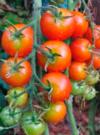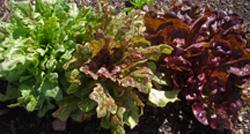
Five Easy Vegetables
for New Food Gardeners
By Master Gardener Stephanie Wrightson
Are you ready to jump into home food gardening? Picking a luscious tomato that tastes better than anything you can buy at the store is a real motivator. Growing your own means that you can choose unusual varieties, and you can grow them inexpensively. Also, it’s a fun and educational summer project for you and your children or grandchildren.
My advice: Start with a small bed—use good compost and it will provide all the nutrients that your crops will need. Start with easy-to-grow vegetables. Suggestions include

A fifth easy vegetable can be direct seeded or transplanted now—leaf lettuce, a

Direct seeding basics:
- Seeds are planted to a depth two to four times their diameter.
- Check the SCMG “Year-Round Gardening in Sonoma County” for spacing suggestions.
- Seeds must have direct contact with soil. If necessary, rake or break up the soil into smaller particles before sowing.
- Wet the soil a couple days before sowing. Keep the soil evenly moist (like a wrung out sponge; not wet). The moisture will cause the seed covering to burst.
- Do not cover seed beds with mulch. Once seedlings are 3 inches or higher, add mulch to keep weed growth down and to reduce evaporation. But keep mulch at least 2 inches away from stems to avoid rot.
Tomato transplant basics:
- Do not buy a large plant in a small container—it will be root bound. Look for an overall healthy appearance (sturdy stems, green leaves that are not drooping).
- Ideally, provide a 12-inch soil depth.
- After digging a larger hole than the roots, carefully ease the plant out of its container; do not grab it by the stem and pull. Disturb the roots as little as possible.
- Take off the lower leaves and plant tomatoes a bit deeper. They will root all along the buried stem.
- You can firm the soil, but do not compact.
- After transplanting, water well and immediately.
- It’s easiest to add a tomato stake or cage while the plant is young.
Other than the earlier advice for lettuce, plant your tallest plants on the north side of the garden. Also, inspect crops every day. Hand pick cucumber beetles when they are slow—early in the morning. A stream of water will knock off the aphids (but be careful with blossoms). Create a trap if you have snails or earwigs. Or exclude pests from small seedlings with a floating row cover. Detailed pest advice is available on UC’s Integrated Pest Management page.
Other tips:
- Sow leaf lettuce every week or two for a continuous harvest until the weather becomes too warm. If you pick only the outside leaves, you can “pick and come again.”
- Pole beans require a trellis or other support. ‘Kentucky’ varieties and ‘Blue Lake’ are reliable producers. Bush beans do not require support. I love growing the slender, sweet French green beans, also known as haricot vert. Blanch French green beans and serve them with a savory dip for an appetizer…they’re not just for dinner.
- My favorite zucchini varieties are bright gold and have a very tender skin and mild taste. Introduce your green-adverse children to a gold zucchini.
- While vining cucumbers take up a lot more real estate, they produce more fruit than bush varieties. Grow a vining variety on a trellis to save space. I love the crunch of pickling cucumbers which I harvest small (5 inches or so). I eat them fresh in salads or give them a quick 2-hour pickle in apple cider vinegar, a little sugar, salt and pepper.
- If this is your first time growing tomatoes, choose a cherry tomato and/or an early-ripening variety. My favorite cherry tomato is ‘Sun Gold’ with its high sugar content. This is good introduction for children who don’t eat many vegetables. Early varieties that are reliable and productive over a long period include ‘Early Girl,’ ‘New Girl’ and ‘Stupice.’ They all require staking or caging. The lighter the fruit color, the less acidic the tomato; if you prefer less acid, try ‘Yellow Pear,’ a mild cherry tomato.
I am very excited! You are embarking on a very rewarding experience. I’d love to hear how your 2015 summer garden thrives. I’m one of the posters on the SCMG Facebook page. Just address me (Stephanie) in one of the comment boxes.






